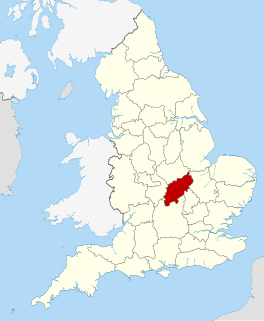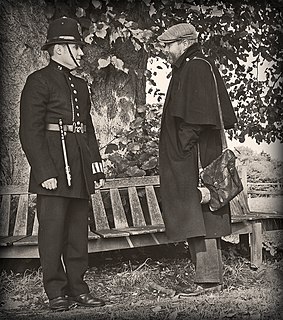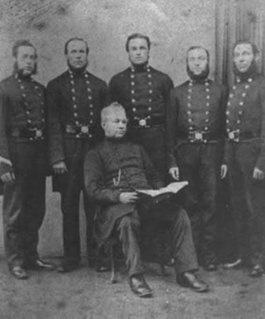
Southampton city police were a police force that operated between 7 March 1836 and 1967 when they were merged into Hampshire Constabulary. [1] [2]

Southampton city police were a police force that operated between 7 March 1836 and 1967 when they were merged into Hampshire Constabulary. [1] [2]
Prior to the formation of the police force the then town of Southampton had a town watch consisting of 12 night watchmen and two day watchmen. [3] It was supervised by the Commissioners for Paving, Watching and Lighting. [3]
In 1835 parliament passed the Municipal Corporation Act which along with broader reorganizations of local government required that the town set up a Watch committee which would recruit a sufficient number of fit men to police the town. [4] The committee decided that a force of 22 constables 2 sergeants and 1 Inspector. [5] The positions of First Sergeant and Second Sergeant were given to the previous heads of the watch while the position of Inspector was given to John Thomas Enright who had been recruited from the metropolitan police. [5] The members of the existing watch were offered positions as constables with 8 of them declining or leaving prior to the swearing in of the new force. [5]
In the first year turnover was high with 14 mean leaving the force largely due to resignations. [6] After this first year turnover fell averaging 28% up to 1840. [7]
A series of robberies in 1851 resulted in the town requesting advice from the Metropolitan police. As a result of this advice the Southampton force to stopped switching constables beats every few days and instead leave them on the same beat for a matter of months. [8]
By August 1857 the police had a force of 30 constables and 7 sergeants. [9] 21 of these constables and 5 of the sergeants covered the night shift while the remainder covered the day shift. [9]
Southampton appointed its first woman police officer in June 1915. [10] In 1919 the number of policewomen on the Southampton force reached six. [11] After the war Southampton reduced the number of policewomen it employed to around two a pattern that continued until the Second World War. [11] None of the women were formally attested. [11] Policewomen numbers again increased with the Second World War and the first regular policewomen were attested in 1942. [11]

The City of Glasgow Police or Glasgow City Police was the police of the City of Glasgow, Scotland. In the 17th century, Scottish cities used to hire watchmen to guard the streets at night, augmenting a force of unpaid citizen constables. On 30 June 1800 the authorities of Glasgow successfully petitioned the British Government to pass the Glasgow Police Act establishing the City of Glasgow Police. It served Glasgow from 1800 to 1975, when it was amalgamated into Strathclyde Police.

Hampshire Constabulary is the territorial police force responsible for policing the counties of Hampshire and the Isle of Wight in South East England, United Kingdom.

Nottinghamshire Police is the territorial police force responsible for policing the shire county of Nottinghamshire and the unitary authority of Nottingham in the East Midlands of England. The area has a population of just over 1 million.

Northamptonshire Police is the territorial police force responsible for policing the county of Northamptonshire in the East Midlands of England, in the United Kingdom.

The Isle of Man Constabulary is the national police service of the Isle of Man, an island of 80,000 inhabitants, situated approximately equidistant from Northern Ireland, Wales, Scotland and England.
The Newport Borough Police was the police force for the borough of Newport, Monmouthshire between 1836 and 1967.
The Police Act 1964 was an Act of the Parliament of the United Kingdom that updated the legislation governing police forces in England and Wales, constituted new police authorities, gave the Home Secretary new powers to supervise local constabularies, and allowed for the amalgamation of existing forces into more efficient units.

The Hampshire and Isle of Wight Fire and Rescue Service (HIWFRS) is the statutory fire and rescue service for the county of Hampshire, including the cities of Southampton and Portsmouth, and the county of the Isle of Wight on the south coast of England. The service was formed on 1 April 2021 from the merger of Hampshire Fire and Rescue Service and the Isle of Wight Fire and Rescue Service. The service's chief fire officer is Neil Odin.
The city of Leicester in England was policed independently until 1 April 1967 when its police force was merged with the Leicestershire and Rutland Constabulary to form the Leicester and Rutland Constabulary.

The history of law enforcement in the United Kingdom charts the development of law enforcement in the United Kingdom. It spans the period from the Middle Ages, through the development of the first modern police force in the world in the 1700s, and subsequent modernization of policing.
Liverpool Parks Police was a police force maintained by the Corporation of Liverpool to police the parks and open spaces owned by the city. The first record of "park constables" in Liverpool is from 1832, although members of the force were not sworn in as constables in their own right until 1882. The force was disbanded in 1972.
Florence Mildred White was an English policewoman. She was likely to have been the first documented woman to join a police force in England and Wales, and to be attested immediately as a Constable. Later she was to become the first attested woman officer holding the rank of Inspector, and the first woman police officer to receive a pension on retirement.

Winchester City Police was the police force of Winchester, Hampshire, England from 1832 to 1943.
Penzance Borough Police was the police force for the borough and corporate town of Penzance, Cornwall, from 1836 to 1947. It was formed following the passing of the Municipal Corporations Act 1835, which reformed all UK boroughs, and stipulated that each appoint a Watch Committee to oversee a police force. The police force formed part of the commonality of the town's government, led by an elected Mayor, six aldermen and eighteen councillors.

Truro City Police, known as Truro Borough Police until 1877, was the police force for the corporate town of Truro, Cornwall, from 1836 to 1921. It was established under the terms of the Municipal Corporations Act 1835 which required every town to appoint a council and a Police Watch Committee, which was responsible for overseeing a police force.

Portsmouth City Police was the city force for Portsmouth, Hampshire from 1836 to 1967.
Women in policing in the United Kingdom began as early as December 1915 amidst the First World War. As with other countries, police forces in the UK were entirely male at the start of the 20th century. Their numbers were limited for many decades, but have gradually increased since the 1970s. In England and Wales, 31.2% (40,319) of police officers were female on 31 March 2020. Previously, women police made up 28.6% in March 2016,and 23.3% in 2007. Women also make up a majority of the non-sworn police staff. Notable women in the police forces include Cressida Dick, the former Commissioner (chief) of the Metropolitan Police Service.

Barbara Denis de Vitré OBE was a British police officer who rose to be the highest ranking in Britain as women became accepted members of the British police.
Nottingham City Police, originally founded as the Borough of Nottingham Police, was a UK police force created under the Municipal Corporations Act 1835 in the style of Robert Peel's Metropolitan Police which initially launched in 1836. This initial force failed and was re-founded successfully in 1841. It had responsibility for law enforcement within the geographic area as defined by the boundaries of the city of Nottingham. Under the Police Act 1964 the force was compulsorily amalgamated with Nottinghamshire County Police to form the Nottinghamshire Combined Constabulary, now re-named Nottinghamshire Police.